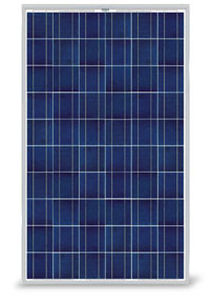Photovoltaic cell or PV cell is the basic unit that produces electricity from sunlight. Each cell produces about 0.5 VDC, the amount of current it produces depends upon its surface area and solar irradiance.
Solar PV cells are connected together to form a Solar PV Panel. Solar Panels are identified by the type of solar Cells used. Typically solar cells are made using single crystal, poly crystal (c-Si) or thin-film amorphous silicon (a-Si). Let's see how they differ in their characteristics.
1) Mono-crystalline 
- Most efficient commercially available solar panels
- Made of one large single crystal of silicon
- Most expensive to produce
- cell shape is square-round
- Module efficiency range from 14 to 19%
- Average efficiency is about 15%
2) Poly-crystalline
- Most commonly used solar panels
- Solar cells made out multi or poly crystalline silicon (mSi). i.e. made from lower purity silicon.
- Reasonably efficient in converting light into electricity.
- Cheaper to manufacture so competitive on a $/watt basis.
- Need more area to produce the same amount of electricity as the mono-crystalline panels.

- cell shape is square
- Module efficiency range from 12 to 16%
- Average efficiency is about 14%
3) Amorphous - Thin Film solar cells
- Solar cells made out amorphous crystalline silicon (aSi)
- Thin-film modules are least expensive to produce but need twice as much area to get the same electricity and so the costs per kWp install even out.
- Thin film can be deposited on flexible substrate for building integrated PV (BIPV)
- Thin film panels are lighter in weight which can be important for large roofs (factory roofs etc) and more flexible which is important for large curved roofs.
- Perform better under low light conditions as they take advantage of wider spectrum of solar light than crystalline cells
- They are also less sensitive to higher temperatures (which affect the performance). This can be a very important consideration for hot countries.
- Because thin-film panels are not modular (made up of small cells connected in series) their output does not drop if only one portion of the panel is shaded. Thin-film panels are thus more shade-tolerant.
- one major disadvantage is its degradation in comparison with crystalline cells.
- Module efficiency 7 to 13%
Monocrystalline PV and polycrystalline PV are the most commonly installed panels accounting for approximately 90% of all modules sold globally in large and small-scale systems. Amorphous silicon accounts for approximately 5% of the global market sales.
Though not common as yet, non-silicon PV cells are entering the market. They are made of thin-film telluride (CdTe), copper indium dislenide (CIS) or copper indium gallium diselenide (CIGS).
Module specifications (Example)
- Voc : Open Circuit Voltage
It is the voltage produced When module is not connected to load - Isc : Short Circuit Current
It is the maximum current that can be produced by the module under the conditions of a circuit with no resistance or a short-circuit. - Pmax : Maximum Power
It is the product of the maximum power voltage (Vmp) and the maximum power current (Imp) at STC - STC: Standard Test Conditions
Standard test conditions at which the specifications are measured. 1000 watts per square meter irradiance, 25 degree C (77F)cell temperature - Power Tolerance
It is the range that a module can deviate from its STC rated power. It varies per panel and manufacturer. Usually it is between +/- 5%. It means that for a 200W panel, it may produce between 190W and 210W. Ideally, installer should prefer positive only tolerance panels. - Module efficiency
It is the ratio of power in the sunlight to the power produced by the module. - Warranty
One should look at warranty carefully. Usually, manufacturers provide 90% output for first 10 years and 80% output for the next 15 years.
